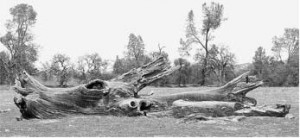We are going back into the archives for this cover of Obispoensis. The landscape is a drawing of the Shell
Creek area that Bonnie drew for the December 1991 cover. The inset is an ID drawing of the leaves and acorn of the valley oak. Why would one want to combine these two pictures? What is the relationship between the two images? What follows is a short history of my encounters with the valley oak tree that became that snag.
I first encountered what was to become the snag in the spring of 1970. As can be seen from the drawing, it stood all by itself in a grassy pasture field. The field is near the junction of Highway 58 and Shell Creek Road. The base of its trunk is drawn showing that it was surrounded by various grass species while the space beyond its drip line (shown empty in the drawing) contained carpets of wildflowers.
The difference in plant species under the tree from that away is due to what has been termed “canopy effect.” Its cause is probably due to the tree, when it was alive, being able to bring water and dissolved minerals up from deep in the soil. Since the tree was somewhat inefficient in using all it brought up, some of these minerals got deposited on the outside of the leaves. This “waste” was washed or dripped off the leaves onto the ground below. Note that the canopy effect persisted several years after the tree had died, so shade was probably not a major factor.
This canopy effect was especially evident when I first encountered the tree in 1970 — the 2nd spring after the record rainfalls of 1968-9. We don’t have any record of the living tree except memory. As can be surmised from the drawing, the tree had died and become a standing snag by December 1991. It fell over sometime
in the late 1990s or early 2000s. After it fell down, the “smaller” branches were harvested for fire wood. But the trunk and bases of the larger branches were so massive that they were not deemed worth the effort to harvest.
Here is a picture of the snag today.  I have visited the snag a number of times over the years. It might seem criminal to let all that wood go to “waste,” but I assure everyone that it is not going to waste. In the years just after it fell over, it was inhabited by termites. These were not in evidence this year probably due to the drought, although I didn’t break into it to check. However I did notice that it is being used as a roof by animals burrowing under it.
I have visited the snag a number of times over the years. It might seem criminal to let all that wood go to “waste,” but I assure everyone that it is not going to waste. In the years just after it fell over, it was inhabited by termites. These were not in evidence this year probably due to the drought, although I didn’t break into it to check. However I did notice that it is being used as a roof by animals burrowing under it.
The inset is Bonnie’s drawing of Quercus lobata leaves and acorn drawn in 1981. Quercus lobata (Fagaceae) is
commonly known as valley oak, California white oak or roble. The last name (roble) was used locally in the name of city, Paso Robles or more correct, Paso de Robles, which translates valley oak pass. Any one who has traveled north on 101 will note that valley oaks are common around Paso Robles and that the city sits in a valley between two high ridges.
I will recite a few notes on valley oaks. They are the largest of our California oak trees. The trunk in the picture above is over five feet in diameter. Valley oak is a true California endemic as its natural range is restricted to the valleys and low hills surrounding the Central Valley and Inner Coast Ranges. Its acorns mature in one year and were used extensively for food by native Californians.
Because the species prefers to grow in deep, fertile valley soils, it has been severely decimated by agriculture. One reason for it current survival numbers for adult trees maybe attributed to its massive size. It was easier to plow or graze around it than to cut it down.
Unfortunately acorns and seedlings are eaten by cattle and rodents, so (as was reported in the current issue of Madrono Volume 61(1) 1-8), there has been little recruitment of new trees. The cause for this lack of survival (recruitment) to older seedlings and saplings is still controversial. I suspect several causes will be ultimately determined. The paper noted that, in their study, lots of seed and early growth seedlings were found. What ever the cause, it also effects blue oak (Quercus douglasii) which is often found upslope from valley oaks.

